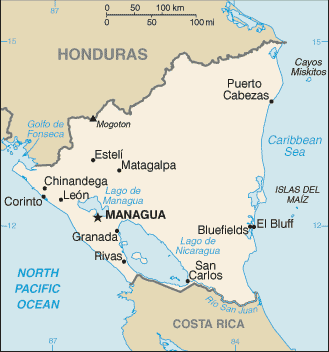America > Nicaragua: Weather, Map, Costs and Travel Guide

Nicaragua : When and where to go?
Click on a city for complete climate and weather tables
| Town | Jan | Feb | Mar | Apr | May | June | July | Aug | Sept | Oct | Nov | Dec |
| Managua |  |  |  |  |  |  |  |  |  |  |  |  |
Nicaragua: Climate & Weather
The climate is tropical, so hot and humid, with a rainy season that extends from May to October in the western sector, and lasts until January on the Caribbean coast. It is characterised by frequent heavy rain with a high risk of hurricanes.
It is therefore preferable to visit Nicaragua sometime between February and April, during the dry season when the temperatures are between 30 and 35°C. The climate does change in different areas, the west is generally open to discovery whatever the season.
Weather today

Partly Cloudy
Wind: 7 km/h
Precipitation forecast: 0 mm
> Full report and 7-days forecast
Data updated at 01:19 (local time)
At that time, the weather was:
 25 °C / Partly Cloudy
25 °C / Partly Cloudy
Nicaragua: Map

Sponsored links
What to do in Nicaragua
The capital, Managua, encircled by lakes and lagoons, is not of any particular interest although Granada, 40 km to the south is a magnificent colonial town with its animated Place Centrale, the white colonnaded cathedral, its town market and the Episcopal Palace.
Cocibolca, otherwise known as the Grand Nicaragua Lake, is one of the largest lakes on the planet and is definitely worth a visit for its tropical plant and animal life. Las Isletas, an archipelago formed of 365 small islands on this lake, can be explored using small boats. One of these small islands is home to an archaeological site with pre-Columbian statues among other things.
The old capital, Leon, remains the intellectual centre of the country due to its universities and cultural richness; the metropolitan Cathedral, various churches, the old colonial houses with their forged ironwork balconies and the ceramics are all worthy attractions of this town.
Ometepe Island is composed of two volcanoes linked by a straight strip of land. It is the site of ruins dating back one thousand years B.C., visiting it is like stepping out of time where various activities are possible at a totally different pace of life to elsewhere.
Nicaragua: The basics
No visa is required for European citizens for a stay of less than three months, a passport valid for six months after your return is sufficient.
The currency in circulation is the Cordoba.
A hotel room will cost around €30, a third of that if you stay in a guesthouse. You can eat for less than €10 if you buy local products, more expensive if you eat in a town restaurant.
Health precautions mainly revolve around the dengue fever so take precautions against the mosquitoes which transmit it. Take a good basic first aid kit with you. Use sealed bottles of water.
For your inland travel, buses can take you all around the country, they are cheap and, although not exactly a smooth ride, they are a great way to meet the local population.
Suggested souvenirs include woven hammocks, golden jewellery, traditional garments, leather objects, cigars, decorated pottery and local rum.



